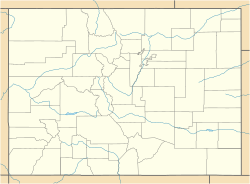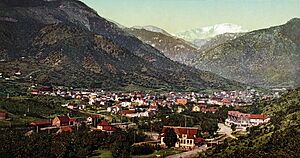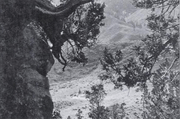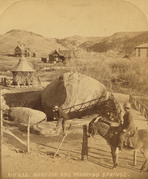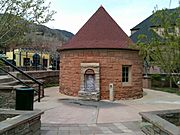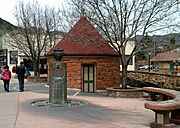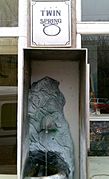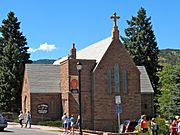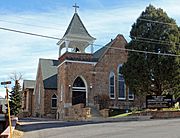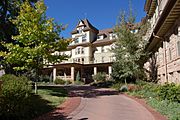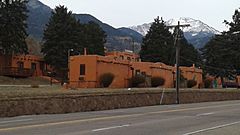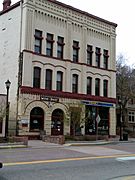Manitou Springs Historic District facts for kids
Quick facts for kids |
|
|
Manitou Springs Historic District
|
|
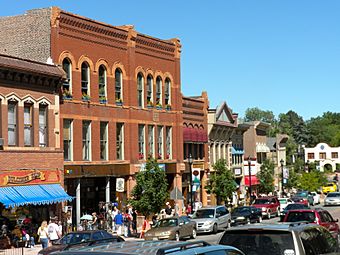
700 block of Manitou Avenue in the Manitou Springs Historic District.
|
|
| Location | Manitou Springs, Colorado |
|---|---|
| NRHP reference No. | 83003516 |
| Added to NRHP | 1983 |
The Manitou Springs Historic District is a special area in Manitou Springs, Colorado. It is a large historic district listed on the National Register of Historic Places. This means it is a very important place in American history. The district is generally located near US 24, Ruxton Avenue, El Paso Boulevard, and Iron Mountain Avenue.
Contents
Discovering Manitou Springs
Manitou Springs is often called "Saratoga of the West." It was created as a resort town. People came here for its special mineral springs and the amazing views of the Rocky Mountains. The town is surrounded by mountains like Mt. Manitou and Red Mountain. It is also close to the famous Garden of the Gods and at the base of Pikes Peak.
Manitou Avenue is the main street where most shops and businesses are found. Some businesses are also on Ruxton Avenue and Canon Street. Homes are built on winding streets that go up the hills, looking over the town. These houses often look like they are stacked on top of each other because of the steep slopes. Since there isn't much flat land for yards, many homes have decks, porches, and stone walls.
The historic district has many different buildings. You can find homes, churches, the public library, hotels, and even the town's natural springs. Many homes are beautiful 19th-century Victorian houses, Queen Anne style homes, and cozy cottages. The Cliff House is one of the old, grand resort hotels with wide porches. In the 1870s, a building company called the Gillis Brothers built many homes and buildings with a "British" style. They built smaller versions of Victorian houses. Some of their projects include Miramont Castle and the First Congregational Church.
Manitou Springs still looks much like it did in the 1800s. This is because it's in a tight valley with hills all around, so there's not much room to build new things. Also, the town works hard to protect its old buildings. Many 19th-century homes and hotels are still there, even if they have been updated. Over time, some old shops have been replaced, and the town has changed to make room for cars and parking.
In 1979, people in Manitou Springs started the Historic Preservation Commission. This group helps protect and improve the town's historic areas. The next year, the Manitou Springs Historic District was officially created. In 1983, the district was added to the National Register of Historic Places. This means it is recognized as a very important historical place in the United States.
Manitou's Special Springs
Manitou Springs is famous for its many mineral springs. Native Americans called these springs manitou, meaning the "breath of the Great Spirit." They believed the spirit created the bubbles in the water. These springs were sacred places where Native Americans drank and bathed to heal themselves. There were about 9 or 10 natural springs. When white settlers arrived, there were conflicts over who could use these special healing waters.
In 1820, explorer Stephen Harriman Long wrote about the water's healing power. Later, George Frederick Ruxton also wrote about the "boiling waters" in his travel book.
About 48 years later, Dr. William Abraham Bell and William Jackson Palmer, a general from the American Civil War, planned to build a health resort. They imagined beautiful summer homes, grand hotels, and parks around the springs. Trains brought many people to the area, which was first called Fountain Colony. The town grew with shops and homes, becoming the first resort town in Colorado.
In 1873, Henry McAllister, who worked for Palmer, promoted the health benefits of the springs. He said Manitou Springs had everything needed for a successful spa resort, including great weather and scenery. However, a financial crisis slowed down the town's growth for almost ten years. The town grew much faster after 1881 when a railway line connected it to Colorado Springs.
Doctors like Edwin Solly said the clean air and sunny Rocky Mountain climate were perfect for treating sicknesses. They also believed in the benefits of the mineral spring water. This brought many tourists and sick people, especially those with tuberculosis, to the area. As the town grew, some springs were covered up. One of these, the Cheyenne Spring House, is made of red sandstone with a cone-shaped roof. After 1900, there were more than 50 wells and springs.
Later, the town's popularity decreased, and some springs were closed or paved over. But in 1987, the Mineral Springs Foundation was created to restore some springs and promote the water's benefits again. Today, you can take walking tours called "Springabouts" to visit the springs. Manitou Springs water was even sold all over the world!
Historic Churches
The historic district has three important churches. These are St. Andrews Episcopal Church, First Congregationalist Church, and Our Lady of Perpetual Help Catholic Church.
The Congregational Church is on 101 Pawnee Street. It was built in 1880 by the Gillis Brothers and is made of stone. The English Gothic Episcopal church is at 808 Manitou Street. It was built in 1905 with help from William Bell, one of the town's founders. The Gothic Catholic Church is at 218 Ruxton Street. It has stone walls and a small grotto. You can reach it by crossing a bridge over Ruxton Creek.
Hotels and Places to Stay
Some of the current hotels and inns in the district include the Craftwood Inn, Cliff House, McLaughlin Family Lodge, and Sunnyside Hotel.
-
Cliff House, built in 1874, was one of the first large hotels in Manitou Springs.
The Sunnyside Hotel on Pawnee Street started as a small cottage and grew over time. As more people began to travel by car, hotels changed to offer parking and easy access. The El Colorado Lodge is a good example of a motel built for car travelers.
Grand Homes and Inns
Beautiful Inns
El Paso Boulevard has several grand houses that are now inns. One is Red Crags, a red sandstone building from the 1890s. It sits dramatically on a slope at 302 El Paso. Nearby are Rockledge Country Inn and Onaledge Bed and Breakfast at 328 El Paso. Both were designed in 1913. They have an Elizabethan architecture style with stucco, stone, and wood. Craftwood Inn, at 404 El Paso, also has an Elizabethan style.
Homes and Museums
Besides the grand houses that are now inns, some are still private homes. Nolan House and Redstone Castle are Queen Anne style homes, both with tall, round towers. Miramont Castle mixes many architectural styles, but it is mostly Queen Anne. There are five other grand houses in the Manitou Springs Historic District. Some are Shingle style, while others are Second Empire, chalet, or a mix of styles.
-
Miramont Castle in Manitou Springs.
Shops and Businesses
Manitou Springs's historic district was built in the 1800s. Because of efforts to preserve its history, the town now has many "quaint boutiques," art galleries, and restaurants.
Other Important Places
- Manitou Incline
- Midland Terminal Railway
- Midland Railroad
- Cog Railroad
- Stone bridge over Fountain Creek in Memorial Park
Images for kids


